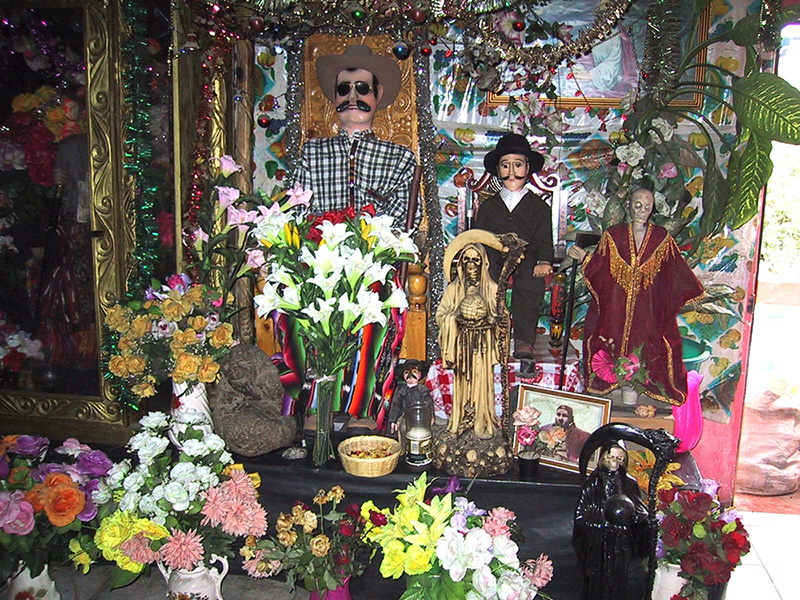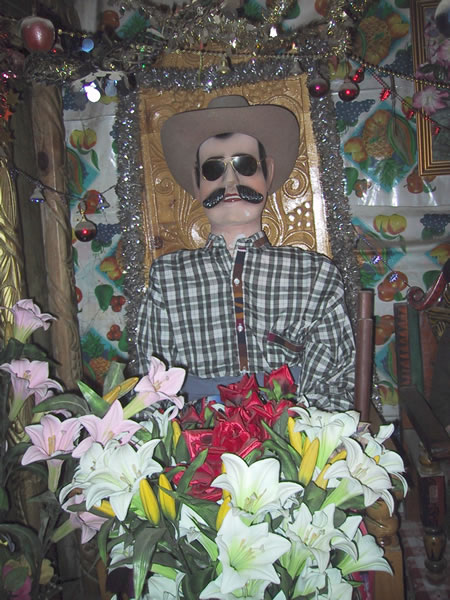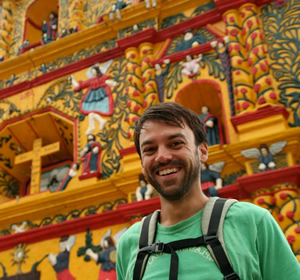A Drinking, Smoking, Womanizing Saint
Article and photos by Ted Campbell

|
|
San Simon Shrine in Chichicastenango, Guatemala.
|
As a heathen I have been either curious, confused, or for the longest time simply disinterested in the significance of the saints. It turns out that when Catholics pray to a saint, they are praying for something specific — help with problems of health, work, or even love, among countless others. Certain saints are more helpful for certain problems. They act as intermediaries between God and us lowly humans.
In the Mayan world, these petitions are done individually or in smoky, spooky ceremonies. The saints are offered money and small gifts, such as carbonated beverages (at least in San Juan Chamula, Chiapas), or even chickens. Incense is burned and candles are lit before their effigies. The color of the candles has meaning as well: white is symbolic for protection of children, yellow is symbolic for personal protection, green is symbolic for hope, red is symbolic for love, and blue is symbolic for work or travel — in Guatemala. In Mexico I found different symbolic color schemes.
The Mayan version of the candle colors is that they represent nature as well, not merely petitions. In the church they only use white and yellow because the monotheistic Catholic Church does not worship nature, since is runs counter to elements of its core beliefs. But the pagan Mayans do, so they burn candles of many colors: blue represents the sky, green represents mountains, brown represents the ground, white represents clouds, black represents the night, yellow represents gold, and red symbolizes love. Pink is seen as a substitute for red and purple is a substitute for blue.
Now, as a mix between seemingly incompatible cultures — Native American and Catholic — strange manifestations and interpretations often occur. For example, you can find Santa Muerte in Tepito, Mexico City´s toughest neighborhood, as well as in towns in Northern Mexico hard hit by the drug prohibition war. Santa Muerte is the saint to pray to if you are a drug dealer, criminal, or just an average person who seeks revenge.
This brings us to San Simon, or Maximon — the same guy with two names. San Simon is the unrecognized Spanish saint, and Maximon is the Mayan shaman. He is the primary saint in Guatemala and you can see effigies to him everywhere, some in special shrines which change houses every year, and some in less likely places like bars or worse. He always looks somewhat the same — with a mustache, cowboy hat, cigarette hanging from his mouth, and surrounded by any number of colorful and odd decorations.

|
|
San Simon in a bar in Guatemala.
|
I found my first San Simon in Zunil, close to Quetzaltenango in the Guatemalan Highlands. This is where I received my first explanation of the man, a slightly different story from others I received at other shrines.
According to a Zunil resident who was hanging out at the shrine, San Simon was a Spanish priest who lived in Zunil around 200 or 300 years ago. Despite being a womanizer and heavy drinker and smoker, he was beloved by the community, one reason being that he let anyone sleep in the church when they needed to. The Catholic Church excommunicated him for his bad behavior and he built his own church in the town. It became more popular than the other church, as was evident by the overflowing gifts of candles and flowers made to him every day.
The Catholic Church destroyed San Simon´s church and left him homeless. He spent the rest of his days in Zunil staying with citizens of the town, continuing his bad-boy ways, forever forgiven and even loved for them.
Now, nowhere else was I told that he lived in Zunil, but that he ceaselessly traveled Guatemala, drinking, smoking, womanizing, but otherwise doing good for everyone he met. Perhaps that is why in each community his effigy is moved from house to house every year. People come and leave him gifts of alcohol and cigarettes and burn candles before him. Playboys are left for him because he liked women so much. He sits with a basket full of coins on his lap, a cigarette in his mouth, a bottle of booze and a shotgun at his side. The money collected is saved for the yearly parties each community has for him, when they parade his effigy around town. While I was in Zunil a woman was sobbing while kneeling before him. His simple chair is surrounded by flowers and white flickering neon lights.
Zunil was my first time meeting San Simon. The second was at the entrance to Pascual Abaj in Chichicastenango, a small hill outside of town where Mayan ceremonies are performed. There is a little ceremonial mask shop and museum at the trail entrance, and the owner there gave me what sounded like a more informed version of the San Simon-Maximon story, maybe because his family had been living at the site and building masks for 300 years.
He told me that San Simon is just the Spanish name for Maximon, a Mayan shaman who lived 500 years ago and was never involved in the Catholic Church. He traveled all over Guatemala, and yes he drank but only because he worked so hard helping the people. His preferred drink was/is cusha, a corn-moonshine which the proprietor was kind enough to serve me for free while he told me stories. It was strong but smooth, a little yellow and a little like mescal, and it cannot be bought in bottles. Cusha is drunk when a Guatemalan comes to ask his girlfriend´s father if he can marry his daughter. The more of it they drink, the more approving Dad is of his future son-in-law.
Handmade ceremonial masks line the walls of the shop, beautiful pieces of art about 10 times more expensive than the tourist ones in the Chichi market. He said that before colonial times his people only used makeup during their ceremonies and started using masks once the Spanish came around.
Also in Chichi and later that same day I found my favorite shrine to San Simon so far. It was upstairs from a bar called “Centro Espiritual San Simon” where I had beers in the afternoon chatting with rum-drinking locals. A girl sat at a table doing her homework. Finally I asked the bartender why the bar was named after San Simon, and they brought me upstairs to the shrine.
I bought a candle and lit it before him. They left me alone up there while I drank my beer and soaked it all in. The shrine was massive — the whole front end of the building — and included at least five San Simons, several Santa Muertes and Virgins of Guadalupe, and all kinds of flowers, fruit, booze, cigarettes, lighting, tinsel, and flashy neon lights.
After a few more chance encounters in different small bars around Guatemala, including a very seedy off-the-map spot in Antigua, I visited the important shrine in Santiago Atitlan. Apparently the top three in the country are Zunil, Santiago Atitlan, and San Andres Itzapa, the last of which I did not visit. In Santiago the shrine is a lot like Zunil — a movable effigy surrounded by other saints and all the offerings left for them — money, rum, candles, and of course cigarettes. Although it was really hard to find and deep up a muddy alley, they expect tourists to come and charge them to enter and take photos, but I was not charged — maybe because I came without a guide, or maybe because I bought a beer and drank it there, evidently a sign of respect for San Simon. Truly, the place could have been a bar — other than all the decorations, it was just a wooden room full of old men sitting around drinking beer and smoking cigarettes.
So what does it all mean? I really cannot say, but I find it massively interesting. That Mexicans have their Virgin of Guadalupe, other Latin countries I have not visited yet have other special saints of which I am not yet aware, but Guatemala has a moonshine-drinking, cigarette-smoking badass to visit and pray to. As mystical as it all is, I guess his vagabond ways add a nice touch of everyday life to a culture of petitioning God for help and favors through what are either deeply spiritual, important ceremonies or simple afternoon drinking sessions.

|
Ted Campbell is a freelance writer, Spanish-English translator, and university teacher living in Mexico.
He has written two guidebooks (ebooks) about Mexico, one for Cancun and the Mayan Riviera and another for San Cristobal de las Casas and Palenque in Chiapas, both also available at Amazon.com or on his website.
For stories of adventure, culture, music, food, and mountain biking, check out his blog No Hay Bronca.
To read his many articles written for TransitionsAbroad.com, see Ted Campbell's bio page.
|
|
